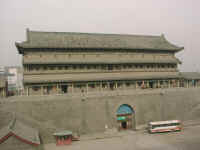|
XIAN Thursday, 13 April. After the breakfast buffet, the bus took us to the West Gate in Xian's old city wall. The city wall is massive, higher and wider than the Great Wall. Another major difference is that the Xian wall is perfectly level. This made it possible to have a moat outside the wall. Even this moat has been preserved. There are four huge gates in the wall, one facing each direction. Each gate has a drawbridge over the moat. Our bus parked just inside the West Gate, and we climbed the many steps to the top. (Jane, still very weak, waited in the bus to preserve energy.) The wide, flat surface of the wall would be perfect for jogging. There was a great view, too.
The bus next took us to a handicraft center. We saw artisans making
lacquered furniture, tie-dying silk scarves, and weaving silk carpets. We
bought some silk scarves and ties, and even a 3 x 5 silk carpet. The
shopping seemed to lift Jane's spirits. By the time we came outside again,
our once beautiful sunny day was becoming very hazy as a dust storm blew
in.
Our next stop was the Banpo Museum. The museum building has been erected over an archeological dig of a Neolithic village dating to 4000 B.C. The village had about 46 buildings and more than 200 inhabitants. It was a matriarchal society based on farming. There were three distinct types of houses (some round, others rectangular), using different construction methods. There was a trench around the entire complex, both for protection and for drainage. There was even a large meeting hall in the center of the village. The villagers made their own stone tools and pottery. A cemetery outside the village contained about 250 bodies, but young children were buried alongside the huts in special clay urns.
Our schedule called for a visit to a noodle factory next, but we went directly to a restaurant for lunch. At a small table near us, one chef was making noodles by hand. That was the noodle factory! Still, it was fascinating to see him start with a roll of dough and wind up with a handful of noodles, just by pulling and folding.
After lunch we went to the museum built over the excavation pits where the Terra Cotta
Army was discovered in 1974. This army was deployed in large subterranean trenches (15-21
feet deep) to protect the tomb of Emperor Qin Shi Huang (259-210 B.C.), less than a mile away.
He was the man who first unified China. He also built the original Great Wall. Using life-size
terra cotta figures was a substitute for live burial, which was practiced earlier in China, as it has
been in several other civilizations. (In live burial, the deceased's servants, wives,
soldiers, etc. were
killed and buried with him.)
There are three pits at the site. The soldiers in Pits #1 and #2 are in battle formation; those in Pit #3 apparently formed an army headquarters. Only a portion of the site has been excavated, so it's uncertain what may yet be found. Pit #1, the largest, contains mainly infantry. About 1,000 of an estimated 6,000 figures of infantrymen, archers, and charioteers have been unearthed there. The terra cotta soldiers, armed with real weapons, were placed four abreast in columns, each column in a separate trench. Wooden beams were placed over the top of each trench, cloth mats over the beams, then earth was piled on top of the mats. Once the soil was compacted and covered by crops or buildings, the army beneath was completely hidden, and remained so for the next 2,200 years. Although we saw the archeologists still digging out soldiers in Pit #1, the main effort has now been shifted to Pit #2. It has approximately 1,400 soldiers (archers, charioteers and cavalrymen) plus 400 horses and 80 chariots. Pit #3 contains 68 figures of officers. The head of each of the many soldiers is unlike any of the others. They were painted in life-like colors, though all but traces of the paint has disappeared in the ensuing 2,000 years. Here is an example of what an archer would have looked like with the original paint. We had a couple of hours to rest back at the hotel before leaving at 6:30 for a Mongolian "hot pot" dinner. (Jane was so exhausted that she stayed in our room. I brought her back some fried rice and rolls.) Each person at the table had a metal bowl of boiling water heated by Sterno. We'd each put a small amount of raw food at a time into the water and let it cook before eating it. Most of the group didn't care for it very much. (I wasn't too thrilled about eating pork cooked this way.) After dinner we returned to the hotel and packed for our departure the next morning.
Copyright © 2000-2023 DarrellPeck.com All rights
reserved. | |||||














